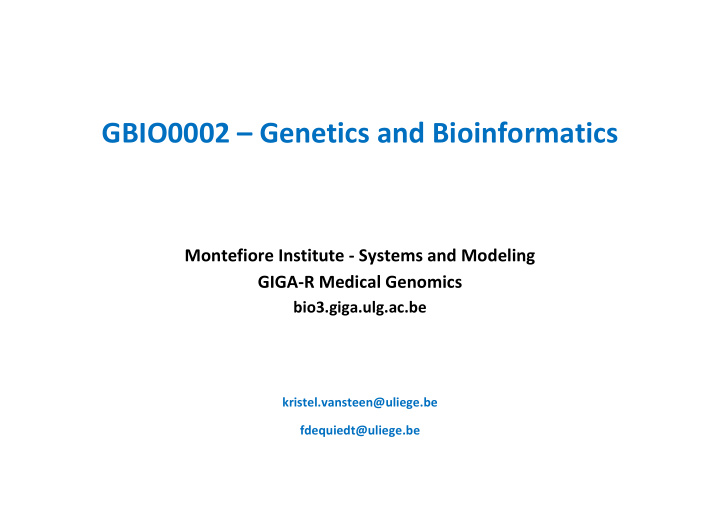



K Van Steen Course Details GBIO0002 – Genetics and Bioinformatics Montefiore Institute - Systems and Modeling GIGA-R Medical Genomics bio3.giga.ulg.ac.be kristel.vansteen@uliege.be fdequiedt@uliege.be K Van Steen
K Van Steen Course Details Administration • Course instructors Prof. Kristel Van Steen - Office: level +5, B34 (GIGA tower) - E-Mail: kristel.VanSteen@uliege.be - bio3.giga.ulg.ac.be/ Prof. Franck DEQUIEDT - Office: level +5, B34 (GIGA tower) - E-Mail: fdequiedt@uliege.be Teaching Assistant (Sept/Oct 2020) - Archana Bhardwaj - Office: level +5, B34 (GIGA tower) - A.Bhardwaj@uliege.be K Van Steen
K Van Steen Course Details Administration • Course website 2012-2021: http://bio3.giga.ulg.ac.be/archana_bhardwaj/?Courses K Van Steen
K Van Steen Course Details Administration http://bio3.giga.ulg.ac.be/ [research BIO3] K Van Steen
K Van Steen Course Details http://bio3.giga.ulg.ac.be/ [events with BIO3 involvement] K Van Steen
K Van Steen Course Details http://bio3.giga.ulg.ac.be/ [educational talks] K Van Steen
K Van Steen Course Details Administration • Complete online form: https://forms.gle/Fd5mpdSiYoUEgKRQ9 Administration K Van Steen
K Van Steen Course Details Uniqueness of “this” course The course “Genetics and Bioinformatics” is unique in the following aims, goals and properties: • Two standalone disciplines, namely “Genetics” and “Bioinformatics” are integrated into one course. Special care is given to the “integration” aspects which underpin this course. We do so in multiple ways: - - There are bridging classes between the two disciplines (e.g., TA, invited speakers) - During the bridging classes software applications are shown, either on analytics seen in class, and/or by building upon these. You are invited to follow on your own computer. - Bioinformatics parts build on Genetics concepts that have been introduced in a foregoing class (there is a logical flow) K Van Steen
K Van Steen Course Details • The learning outcomes are well explained and relate to the following: - understanding key concepts, terminology and their context; - interpreting findings / analysis results (not yet carrying out multiple types of analyses that require a multi-faceted programming skills set). The learning outcomes form the basis for the exam . For instance for the last part, screenshots of analyses runs are shown (as seen in class), which need to be interpreted. K Van Steen
K Van Steen Course Details • Keeping these learning outcomes in mind, interim evaluations are also done in a unique way, for this course: - You are given the choice to select a classical style of homework assignment (i.e. questions & answers) or a literature style homework assignment (i.e. students can suggest papers or select one of the papers proposed to capture the essence, to link back to the course notes materials, to be inspired to look at the broader context and read (or look up) additional materials). K Van Steen
K Van Steen Course Details - This system was inspired by implemented systems in the United States, and gives you the freedom to select the assignment that best matches your background. ▪ Indeed, this course has a history of having a heterogeneous student population and bachelor students may have more difficulties in finding their way in scientific literature in English than master students can. ▪ Furthermore, the fact that students suggest their own papers adds an extra layer of accommodation towards the student. ▪ Furthermore, guidelines are provided in class about “how to critically evaluate a paper”, as we experienced that often students lack knowledge about the basic underlying principles to critically evaluate a paper. K Van Steen
K Van Steen Course Details - As a consequence, reading papers and processing these in view of the course (including forming evidence-based opinions), is crucial to this course. ▪ It brings you into the real-life experience of a bioinformatician in that there is an abundance of information out there and that an abundance of materials can be found even when modifying just a few conditions underlying a bioinformatics analysis. ▪ Anyone working in a bioinformatics environment will testify that a big part of the time is spent on browsing the literature for pros and cons of adopted methods or on identifying new routes of analyses that can increase optimality. ▪ In this course, you are exposed to such a situation, in a mini-version. Furthermore, you will need to work in groups on assignments, also mimicking real-life situations for most bioinformatics professionals, adding on an extra component of “project management & communication” to the course. K Van Steen
K Van Steen Course Details • Clear selection of subtopics: avoiding not seeing the trees for the forest - Bioinformatics and Genetics are broad topics - An overview of multiple Bioinformatics topics, possibly unlinked to each other, is given in the course GBIO0009. - For GBIO0002, we have made the decision to consider a red thread via “genome - wide association studies” (GWAS). ▪ Analyses and post-analyses of GWAS link to multiple sub-disciplines using different data sources, including gene expression and protein interactions. ▪ These links are covered in the course, from a “genetics perspective” (f.i. including the coverage of underlying data generating technologies) and from a “bioinformatics” perspective (which is taken to be an “data analytic” perspective). K Van Steen
K Van Steen Course Details Course schedule Information about the organization of feedback sessions to homework evaluations will follow K Van Steen
Recommend
More recommend